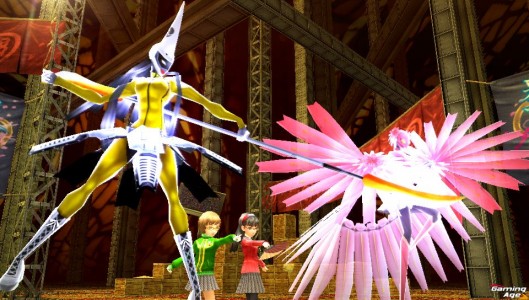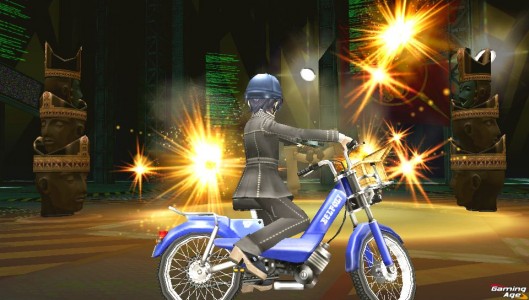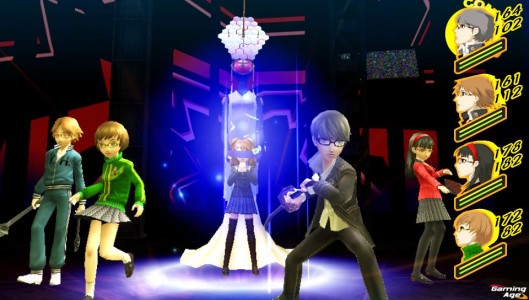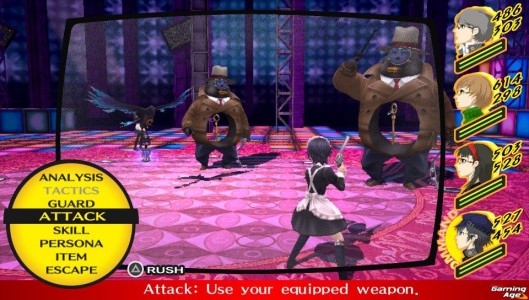Publisher: Atlus
Developer: Atlus
Medium: Vita Card/Digital
Players: 1
Online: Yes
ESRB: M
If you played Persona 4 on the PS2, I doubt that I really need to tell you that it?s a pretty awesome RPG, and easily one of the best on Sony?s last-gen platform. Hell, it remains one of the best Japanese RPG?s developed this decade or last, and stands out as the pinnacle of Atlus? Persona series in my opinion. So when I say that Persona 4 Golden is a must buy for Vita owners, I imagine you won?t find that too surprising.
And as far as ports go, Persona 4 Golden is top notch. You?ve got a substantial amount of added content, along with all the previous content that made the original game so great. If you haven?t played the original game, you?re going to be in for a real treat here. In Persona 4 you take on the role a young high school student transferred to a new school to live with his uncle and young cousin. You end up befriending a small group of eclectic friends. Just as quickly you become embroiled in a series of mysterious murders plaguing the region, and along with your friends, unlock the ability to unleash Persona, powerful spirits, which you?ll use in combat against shadow creatures and other monsters.
 The combat system in Persona 4 Golden consists of four person groups, where you can either directly control your teammates or allow the AI to do the lifting. The AI isn?t really up to the job though, you?ll most likely want to take direct control at all times, especially considering the system relies heavily on a rock/paper/scissors system of exploiting weaknesses and strengths in most fights. If you?re familiar with most modern Shin Megami Tensei titles, this system will probably be second nature. Character Persona?s are typically outfitted with lightning, dark, light, fire, ice, or wind properties, and are typically weak to the opposite. Most enemies are the same, and boss fights require smart use of these elemental weaknesses to overcome. This is completely unchanged from the original version of the game, and the default difficulty feels on par with the original.
The combat system in Persona 4 Golden consists of four person groups, where you can either directly control your teammates or allow the AI to do the lifting. The AI isn?t really up to the job though, you?ll most likely want to take direct control at all times, especially considering the system relies heavily on a rock/paper/scissors system of exploiting weaknesses and strengths in most fights. If you?re familiar with most modern Shin Megami Tensei titles, this system will probably be second nature. Character Persona?s are typically outfitted with lightning, dark, light, fire, ice, or wind properties, and are typically weak to the opposite. Most enemies are the same, and boss fights require smart use of these elemental weaknesses to overcome. This is completely unchanged from the original version of the game, and the default difficulty feels on par with the original.
The exploration side of the game involves a handful of areas accessible outside of the main dungeon worlds, allowing you to visit shops, your local school, a mall dubbed Junes, and a riverfront/plains area. You can easily move between areas by bringing up a quick travel menu at any time, or opt to walk from location to location, exiting out to an overworld map when you reach the end of an area. These locations can be rife with side quests to tackle, and also offer up the locations where you?ll be spending time maxing out your all important Social Links.
 The Social Link system allows you to mature your relationships with fellow students, your battle group, and other strangers. These sequences usually involve spending a chunk of time on a certain day of the week with the other individual, engaging in conversation options, and attempting to gain some sort of new understanding or insight into that person. If done successfully, you can level up your link with that person. Doing so ties back into the Personas you can create, by fusing together one Persona with another. When you fuse Personas, you?ll create a new one of a certain type, and if that type matches the Social Link, you?ll get an experience boost. So it pays to max out these relationships when possible, and there?s an interesting mechanic present in Persona 4 that really challenges you to use your time wisely, with some neat risk/reward elements in place.
The Social Link system allows you to mature your relationships with fellow students, your battle group, and other strangers. These sequences usually involve spending a chunk of time on a certain day of the week with the other individual, engaging in conversation options, and attempting to gain some sort of new understanding or insight into that person. If done successfully, you can level up your link with that person. Doing so ties back into the Personas you can create, by fusing together one Persona with another. When you fuse Personas, you?ll create a new one of a certain type, and if that type matches the Social Link, you?ll get an experience boost. So it pays to max out these relationships when possible, and there?s an interesting mechanic present in Persona 4 that really challenges you to use your time wisely, with some neat risk/reward elements in place.
As far as the new additions to the game found in the Vita port, there?s a number worth mentioning. There are two new Social Links, one of which comes from a new character that gets introduced mysteriously early on (as early as the intro sequence). Other changes are a little more nuanced, like the option to save your game almost at the onset of your adventure, instantly making the game a little more portable appropriate. There?s also an option to leave your house at night and explore the nightlife of the area, giving you new people to encounter and options to explore. There?s also some interesting online functionality, which will allow you to call on the help of other players for battles, and you?ll have the option to see how other players chose to spend any day you?re currently on. This latter feature is particularly awesome, it?s really neat to see how others used their time at different points, and helps give you some opportune pointers if you?re having trouble making a decision.
 There are also some additional features for the fan base, in the form of TV stations accessible from the main menu of the game, allowing you to view Japanese commercials for Persona 4 and other Persona titles. There?s also some cool live footage of concerts for soundtrack fans, which I found particularly fun to check out. It?s not exactly game changing stuff, but the additional content is well presented, and doesn?t come through in some awful, low resolution video. I love seeing stuff like this as additional features, more so than your standard concept art, so I definitely appreciate the addition.
There are also some additional features for the fan base, in the form of TV stations accessible from the main menu of the game, allowing you to view Japanese commercials for Persona 4 and other Persona titles. There?s also some cool live footage of concerts for soundtrack fans, which I found particularly fun to check out. It?s not exactly game changing stuff, but the additional content is well presented, and doesn?t come through in some awful, low resolution video. I love seeing stuff like this as additional features, more so than your standard concept art, so I definitely appreciate the addition.
One of the things that really sold me on Persona 4 the first time I played through was the fantastic character development. While your character, the unnamed protagonist, is more of a blank slate for everyone else to play off of, every character introduced via Social Links or the main party group are extremely well fleshed out and detailed. Regardless of how late in the game a person is introduced, it?s almost guaranteed that you?ll get some sort of resolution as far as their individual story goes. While the combat system in Persona 4 might not be categorized as amazing, the way it deals with story and plot progression, and gives you a number of fully realized characters, is.
 I was also pleasantly surprised out how well the game transitions to a handheld platform. It?s no secret that this is a very long RPG, but it?s easily consumed in small chunks, and the small changes to where and when you can save make this perfect for picking up and playing any time. It also helps being able to suspend the game any time via the Vita?s OS, allowing you to more or less quick save any time you want, provided you don?t need to access another program or game.
I was also pleasantly surprised out how well the game transitions to a handheld platform. It?s no secret that this is a very long RPG, but it?s easily consumed in small chunks, and the small changes to where and when you can save make this perfect for picking up and playing any time. It also helps being able to suspend the game any time via the Vita?s OS, allowing you to more or less quick save any time you want, provided you don?t need to access another program or game.
Also, despite playing through the game fully and maxing out all Social Links back on the PS2, I had no trouble wanting to play through the experience a second time on the Vita. So if you?ve had the pleasure of playing the game previously, rest assured you?ll have an equally hard time putting it down on the Vita, much like the original on PS2. And for new players, I envy the ability to go into this game fresh again, because it?s really one of the best RPG experiences of the past two console generations. For either or, previous Persona 4 players or newcomers, this is one Vita game that can?t be missed.

